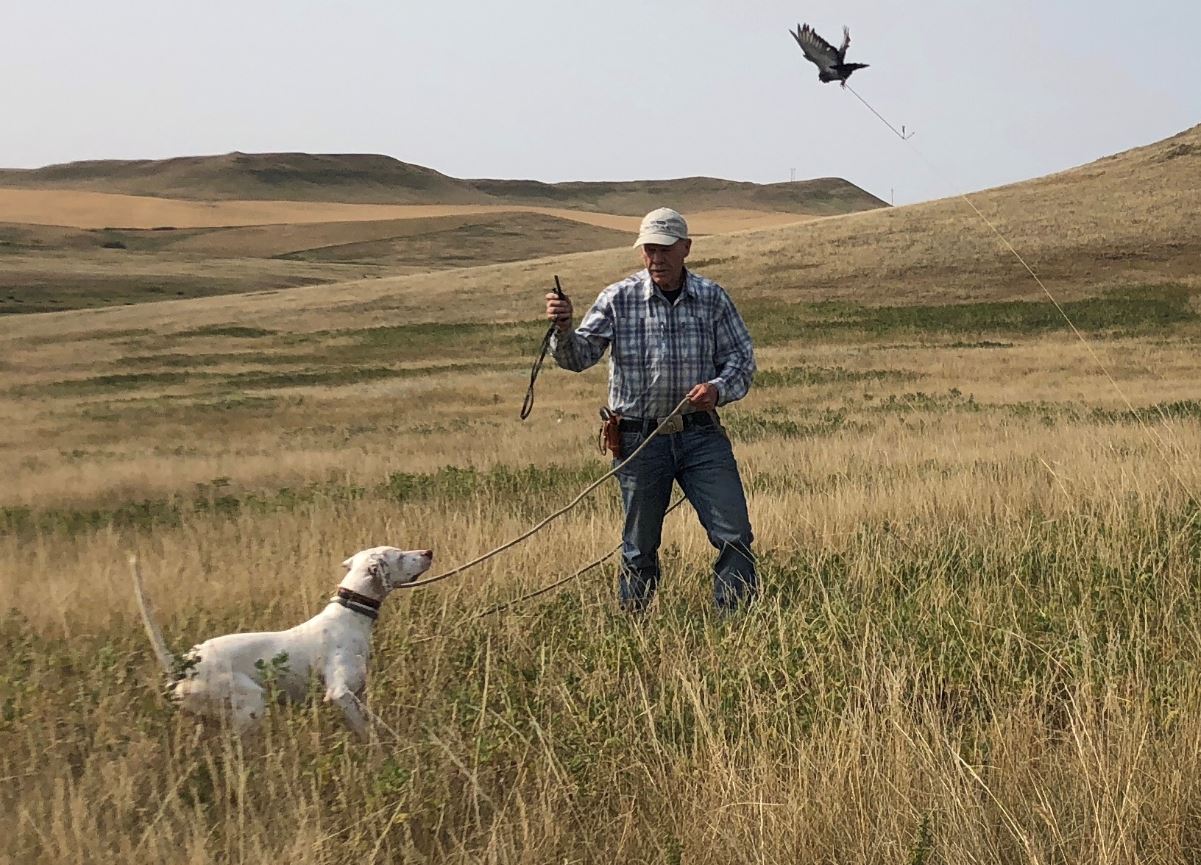Upland bird seasons are in the air, and it’s time to tune up your pointing dog with this 4-part approach
By Steve Hickoff
His name is synonymous with steady, thoughtful dog training. Emphasizing proper bird manners and conditioning, George Hickox’s training methods are well-known by those who attend his clinics. I recently caught up with him in North Dakota, where he trains bird dogs on the summer prairie. Winter training grounds are in Georgia.
Pheasants. Quail. His dogs handle both.
“There are two types of dogs out there,” Hickox said. “One dog holds point and handles in range. It has at least one hunting season behind it. This dog has acceptable bird manners for the owner. Another dog, say a 10-month-old pup, is not fully trained and will chase. Learning and teaching is the same for both.”
1 - Bird Manners
“The manners of a more advanced dog are probably pretty good anyway. This dog should hold point on wild game – and during pre-season pigeon drills in summer. It stays in range, moving from 10 to 2 o’clock out in front. I don’t want him running behind me. Most pre-season work with this advanced dog is conditioning,” said Hickox.
“Obedience training would have been done when he was a youngster,” he continued. “The only way this needs to be addressed is if the owner gets in the habit of saying the command over and over, and it results in the dog’s non-compliance. This unfortunately sometimes comes with the handler’s variable reinforcement.”
How do you fix this training error?
“Only say the command once,” Hickox said. “Not a second and a third time. This puts even more pressure on a dog. And more pressure does not create more style. You want the dog to respond on the first command. If a second and third command is given, the dog can’t learn to respond to the first cue. Variable reinforcement ensures a dog will need more correction.”
His advice? Make sure the dog knows why he was rewarded – and corrected. “Correcting a dog that doesn’t understand the correction leads to apprehension and a dog that’s not open to learning,” Hickox stressed. “If training breaks down, go back to yard work. Obedience training should be done there and not the field. And not the day before the opener.”
“Pups and advanced dogs both need birds,” Hickox said. “Put a pup on pen-raised or wild birds. Serious formal training will come later. For now, basic commands – and yard training showing the young dog what you want – are in order. But again, getting the pup into birds is essential. Short, frequent training sessions do this.”
Below: George Hickox works a year-old pointer in pre-season point drills. (Photo Courtesy George Hickox)

2 - Clicker Training for Pups
With a young dog, Hickox uses clicker training.
“During yard work, teach the pup a certain behavior,” Hickox said. “Use the clicker to identify the behavior as it occurs. Then reward the dog. Cause. Effect. Once the young dog makes this association, introduce commands. Clicker training is schooling the dog. It builds enthusiasm. First teach the behavior you want; then reward the dog for it. A hungry dog is more motivated.”
Don’t reinforce bad behavior. “There’s no substitute for consistent repetitions,” Hickox said. “Make yard training a learning area. Make school fun for the dog.”
It’s also not realistic everyone in the family will have the same commitment and consistency with your bird dog as you do. “Train in a special place. Make it an area where it’s just you and your dog,” Hickox said.
“If the dog is 12, 14, 18 months old, start working on point drills. Put him on a check cord. Give him two birds. Plant a scent bird and have a launcher bird outside the first bird’s scent cone. Use a helper. When he goes on point, the scent bird holds him. And the launcher bird allows for even more training. He’s rewarded twice. This is when you’ll start to see bird manners you can work on.”
3 -Veteran Dogs
Pointing. Backing. Being steady to wing and shot. Retrieving to hand. Handling and control are foremost with Hickox. And as always, he emphasizes consistency with commands.
“For an older dog, he should already know commands with e-collar training,” Hickox said. “If he’s had a good year the previous hunting season, it’s realistic to think the dog will this year too.”
Reinforce the good behavior. “A pointing dog needs the bird as the reward,” Hickox said. Emphasize conditioning, bird manners. “Once the older dog doesn’t need correction, he’s trained.”
4 - Conditioning
For the advanced pointing dog, conditioning rules. “That’s a biggie,” Hickox said. “If a dog is well-conditioned, they handle heat better.”
His advice? “Run your advanced dog slowly for long distances. Time not speed is important here. For a younger dog, 15 to 20 minutes is good. Pay attention to the heat for both.”
According to Hickox, with an older dog, pre-season conditioning should include aerobic training (slow, long-distance training) and resistance training (using a four-wheeler with a dog harness). He doesn’t road train dogs under a year and a half old. “We have no overweight dogs,” Hickox said. “They look like marathon runners.”
Bonus Feeding Tip
“Dogs in good condition, on a proper diet, and well-hydrated, that’s the key,” said Hickox. He feeds
Purina Pro Plan Sport (https://www.proplan.com/dogs/platforms/sport) “A dog needs to be fed like an athlete. But don’t feed in the morning before a hunt. That’s a no-no. Feed no sooner than two hours before exercise, and at least one hour after.”
Learn about George Hickox and his Bird Dog Training school at
georgehickox.com.
Outdoor writer Steve Hickoff is a Pheasants Forever and Quail Forever member who bird hunts around the country, most often with his English setters, but other dogs too.